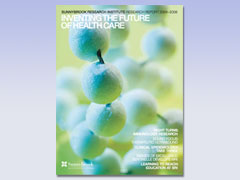Fingers on the Pulse
The beating heart is the constant for cardiac surgeons, the pulsating index of their success or failure, the animated background set piece to the unfolding drama of improving health care with technical excellence and a relentless pursuit of better ways to get things done. So it is with Drs. Stephen Fremes and Nimesh Desai, two Sunnybrook heart surgeons who regarded with interest the scripted evolution of bypass graft materials over the years—and never felt convinced that the plot had resolved itself to their satisfaction.
For all of its leaps-and-bounds advances, bypass surgery is a guarantee of nothing. The saphenous vein that typically bridges the faulty chasm for heart patients is notoriously short-lived. By 10 years after surgery, almost one-half of the grafts have failed. Their hosts may have suffered more angina, heart attacks or heart failure. Still, this ankle-to-thigh vein was the conduit of choice for more years of heart surgery's history than anything else. It's easy to access, the right size and, in most people, in decent enough shape for harvesting.
In the 1980s and 1990s, though, the saphenous vein's uncontested position was challenged by surgeons' increasingly regular use of an artery on the chest wall, initiating the age during which the saphenous standard was supplanted with the saphenous and internal thoracic artery combination.
n the face of it, an artery is an obvious improvement on a vein for bypass surgery. After all, arteries are used to systemize blood pressure, and the blood inside veins only trickles—doesn't bound—back to the heart. Veins' failure rates are often pegged on this shortcoming. They're not accustomed to high blood pressure, and there is speculation that its demanding presence for this adapted application causes the veins to thicken and, over time, close.
It surprised no-one, then, to discover that, if used as a bypass graft, the thoracic artery lasts longer than the vein. In fact, it almost never breaks down. After 10 years, research has revealed that more than 95% of them are still functioning. But this chest-wall vessel is more delicate to work with and trickier to extract than its predecessor. It also carries with it the risk of bone infection in response to the necessary closing-off of circulation to the breastbone during surgery.
Surely, thought Fremes and Desai, the perfect bypass graft material was yet to be identified.
The radial artery, which carries the body's pulse through the forearm, was first engaged in bypass surgeries in the 1970s, but with limited success. Some 20 years later, a paper came from Paris inviting the medical community to reconsider it as an alternative to the saphenous vein, which was producing worrying results for the blockages that were developing late after surgery. Fast-forward to today, when tissue-handling techniques have progressed to where, physicians hypothesize, it may be entirely reasonable to celebrate this alternate artery's role in heart surgery. It looked promising for its speculative ability to offer the same longevity as the internal thoracic artery without the surgical demands or attendant side effects.
Moreover, Fremes, who is a senior scientist at Sunnybrook Research Institute, had a personal interest in the subject. "Most surgeons have something they're known for," he says. "I had a reputation for being a very good coronary surgeon." He was troubled, though, by the coincidence of the risk of vein-graft disease and late cardiac events among the two-thirds of patients who die beyond the first one to 12 months following coronary surgery. "That's the scientific rationale for looking at other bypasses."
At the time of the study's launch, the radial artery was acknowledged for various intrinsic advantages, but was also suffering variable reports about whether its results could be characterized as excellent or mediocre. Ultimately, there was equipoise, meaning that the information relating to the question was balanced: there was no good evidence in favour or not of the radial artery.
Recruitment for the study took place between 1996 and 2001. It was a multicentre trial that spanned the country and included one international site. Results were published in The New England Journal of Medicine in 2004.
One year postoperatively, tests of the 561 participants revealed a significantly greater proportion of the radial arteries were functioning better than the saphenous veins. What's more, the radials were 40% less likely to fail at one year.
The research also spoke convincingly of the link between radial patency—the state of being open and unblocked, and a key predictor of long-term survival—and the extent of disease within the target vessel. If a vessel had a 90% or higher obstruction, the radial artery would remain patent; if the obstruction was between 70% and 90%, patency declined. "That's something that surprised us," says Fremes.
All told, says Desai, who is a research fellow and chief cardiac surgery resident at Sunnybrook, "the results were very encouraging. They confirmed what we were doing in clinical practice, and will hopefully persuade others to look at that strategy, as well."
In practical terms, it means cardiac surgeons at Sunnybrook—and those throughout the world, particularly in Australia and Europe—are expanding their use of the radial artery on the strength of this evidence that it will eventually surpass the saphenous vein in effectiveness.
Up next for Fremes and Desai: a five-year examination of postoperative outcomes, along with studies that seek to understand why bypass grafts fail over the long term.
The drama continues.
Fremes's and Desai's research was funded by the Canadian Institutes of Health Research.
PDF / View full media release »





